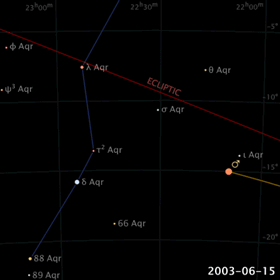Apparent Planet Motion
5.3 - Understand the changing position of the planets in the night sky5.5 - Understand the observed retrograde motion of planets
Imagine you are travelling alongside another car on the motorway. There will be times when the other car is ahead of you, behind you and alongside you, depending on the curve of the road and your speeds.
It is like this with planets. Both Earth and Mars, for example, travel in different orbits and at different speeds. Mars’ position in the sky if you view it from the Sun would be quite simple to figure out. Locating it in the sky from Earth is a lot more difficult because Earth is also moving.
The planets are in constant motion and the position of a planet can noticeably change over the course of a few days moving westwards.
Direct Motion
A planetary track is the path a planet makes on a star map. When a superior planet (one that is outside of Earth’s orbit) moves in the sky it usually moves from right to left (or east to west). When it moves like this it we call it direct motion, sometimes called prograde.
Stationary Point
There will be times when it does not appear to move at all. We call this a stationary point.
Retrograde Motion
Then we may see the planet move backwards from where it was. Moving in the opposite direction is called retrograde.
This happens because Earth is nearer the Sun and has a smaller orbit. The planet appears to move normally but then Earth catches up with the planet. When they are aligned the planet may appear to stay still (stationary point). The planet then appears to move backwards (retrograde) as Earth moves in front. Eventually the planets realign and the planet moves directly.
Animation
Mix & Match
Questions
Below is the apparent movement of a planet over the course of a number of weeks. What is the name of the movement at points A, B & C?

Define the terms
a) Retrograde
b) Stationary Point
Summary
Planets appear to stay still and move backwards in the sky over a period of time. This is due to the speed of Earth's orbit.
Links
- University of Hawaii Paths of Planets
- Science U The retrograde motion of planets


 | © All Rights Reserved |
| © All Rights Reserved |